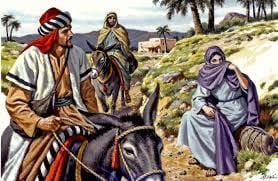Old Testament Reading: Isaiah 40:1-11 – New Testament Reading: Revelation 7:9-17
The Five Women in the Lineage of Jesus
“Tamar: The Seeker of Justice”
Matthew 1:1-17, Genesis 38:1-30
Wayne J. Edwards, Pastor
When it comes to reading the genealogies in the Bible, most readers overlook them, not only because they can’t pronounce the names, but because they don’t understand their theological significance to God’s eternal plan for our redemption.
- Therefore, in reading the Christmas Story, most readers begin in Luke 2:1, or Matthew 1:18 with the birth of Jesus.
- However, the whole Christmas story begins in Matthew 1:1, with “the record of the genealogy of Jesus, the son of David, the son of Abraham.”
- The expression, “the record of the genealogy” in the Greek text reads, “the book of the genesis of Jesus Christ.”
- Because of their prejudicial concern over bloodlines, Jews paid close attention to genealogies, which is why Matthew and Luke introduced their gospels with a detailed genealogy of Jesus.
- According to biblical prophecy, the Messiah had to be from the lineage of Abraham and David.
- In the second chapter of his gospel, Luke recorded Joseph and Mary’s journey from Nazareth to Bethlehem, to register for the census, because Joseph was “of the house and family of David.”
Matthew included five women in his genealogy of Jesus, four of whom were not the kind of women one would expect to be included in the lineage of the Messiah.
- Tamar – the daughter-in-law of Judah, who was the son of Jacob, and the grandson of Abraham.
- Tamar deceived Judah into having sexual relations with her, and she became pregnant with two sons, one of whom became the seed-son of the Savior, Jesus Christ.
- Rahab – the woman whose name is always followed by her occupation – the harlot.
- Rahab lied to the authorities about the location of the spies, but the writer of Hebrews referred to her as “a woman of faith in the God of Israel.”
- Ruth – a Moabite woman; the daughter of the incestuous relationship between Lot and one of his daughters.
- Ruth was a Moabite woman who married Boaz, a Jewish man, who became David’s great-grandmother.
- Bathsheba – is always identified as Uriah’s wife.
- After the child of David’s adultery with Bathsheba died, David married Bathsheba, and they birthed another son named Solomon, who was in the direct lineage of Jesus.
Why would the Holy Spirit inspire Matthew to include the names of these four women in the lineage of Jesus?
- To send a message to the self-righteous not to think more highly of themselves, or to look down upon those who were forbidden to attend the Temple Services because of their sins, for Jesus was a “Friend of sinners.”
- To display the richness of God’s Amazing Grace, that we all have sinned and fallen short of the glory of God, and that Jesus said He had not come to “call the righteous to repentance,” but rather He had come “to seek and to save that which was lost.”
- Mary – while the purest of the five, Mary was the most unlikely person to be chosen as the mother of Jesus.
- Mary was a devout believer in God who trusted Him with her reputation and her future.
- Even at the age of 14, Mary had such faith in God that when she finally understood what God was doing through her, she cried out, “Behold the bond-slave of the Lord: may it be done to me according to Your word.”
THE LIFE OF TAMAR
1. Judah’s failure – Genesis 38:1-11
- 1 – “Judah went down from his brethren.”
- Judah was unaware God had chosen Him to be the channel of the Messiah.
- After participating with his brothers in selling Joseph to the slave traders, and telling their father he had died, Judah left his father, his family, and his faith in God, and united with the ungodly Canaanites.
- Judah chose a Canaanite wife, who bore him three sons:
- Er – who married Tamar, but was so evil he died.
- Onan – who refused to marry Tamar and he died.
- Shelah – who would not “fully” marry Tamar.
2. Judah’s Fornication – Genesis 38:12-19
- Since Tamar was not allowed to marry outside Judah’s family, and Judah would not allow Shelah to marry her, Tamar deceived Judah into having sexual relations with her, and she conceived with twin sons.
- Tamar presented herself to Judah as a prostitute and demanded a “pledge” be given to her until she received the payment for services Judah had promised.
- Judah gave her his seal – a ring, his cord, and his staff.
- Both Judah and Tamar were wrong, but in God’s sovereignty, a man-child was born from the lineage of Judah through whom the Messiah would be born.
3. Judah’s Folly – Genesis 38:20-26
- When Judah discovered Tamar was pregnant, he quickly accused her of harlotry and demanded she be brought forth and burned.
- However, as Tamar was being brought out to be burned, Judah received a letter from her, telling him the man to whom these three things belonged was the father of her child, and she produced Judah’s ring, cord and staff.
- When Judah discovered he was the source of Tamar’s pregnancy he declared: “She is more righteous than I, in as much as I did not give her my son, Shelah!”
- This event changed Judah’s heart toward Tamar, his two new sons, his father, his family and his God – Judah took the initiative in restoring the broken relationships
- While none of this was in God’s perfect will for Judah or Tamar, obviously it was within His permissive will, which is why He used it for His purposes.
- God took an immoral event that Satan meant for evil, and He used it to display His Amazing grace.
- God chose Tamar, and one of her twin sons to be included in the genealogy of Jesus, who became our Savior.
4. Jesus’ Family – Genesis 38:27-30
- Tamar gave birth to two sons:
- Zarah – which meant “rising one” – the one Tamar thought would be the firstborn.
- Perez – which meant “one who breaks through” – the one God chose to be the seed-son of the Savior.
Genesis 38 stands as a most blessed display of God’s amazing grace to sinners. The events of Genesis 38 should:
- Affirm our faith in God’s divine providence.
- Even though Judah and Tamar were actively engaged in sin, God was working things out behind the scenes according to His divine plan.
- Affirm our faith in God’s divine election.
- There was nothing good or noble about Judah – every choice he made was out of selfishness, but God had chosen Judah as the seed-son, and so it would be.
- There was nothing holy or pure about Tamar – she had no comprehension of a covenant God, but God chose to provide a way for her to receive salvation, even through the birth of her “incestuous” son.
- Affirm our faith in God’s immutability.
- God had chosen the seed-line to flow through Judah.
- Man’s sinfulness could not frustrate God’s plans; what He had ordained would be carried out.
- Affirm our faith in God’s impartiality.
- Just as God dealt with Judah and Tamar, so He deals with everyone – by His grace alone.
- God even uses our gravest sins to achieve His sovereign purpose, including our red
“No pit of sin is so deep that God’s grace is not deeper still.”
Adapted from Corrie Ten Boon






